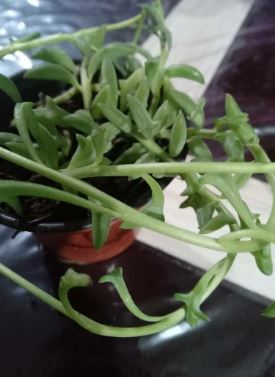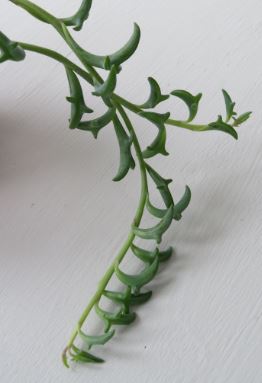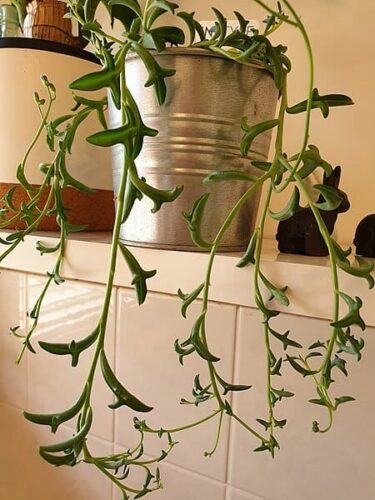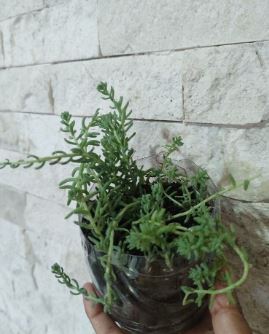The string of dolphins, known for its captivating cascading vines resembling leaping dolphins, is a unique and beloved succulent. Among the various challenges that enthusiasts may encounter in their care routine, one prominent concern is the occurrence of flat leaves. In this article, we will delve into the reasons behind the flattening of string of dolphins leaves and provide comprehensive guidance on addressing this issue. Understanding the interplay of factors such as overwatering, light exposure, and nutrient deficiencies is crucial for ensuring the health and vibrancy of your plant.
Why Are My Dolphin Plant Leaves Flat?
Overwatering
If you’ve noticed your string of dolphins’ leaves taking on a flattened appearance, overwatering might be the culprit. Succulents, including the string of dolphins, are adapted to arid conditions and have specialized mechanisms to store water. When excess water is present in the soil, the leaves can become waterlogged, losing their natural plumpness. Signs of overwatering include soft, translucent leaves and, in severe cases, a mushy texture. Adjusting your watering practices is key to resolving this issue.
Insufficient Light
Insufficient light can also contribute to the flattening of string of dolphins leaves. These plants thrive in bright, indirect light, and a lack of sunlight can impede their ability to photosynthesize and maintain sturdy foliage. If your string of dolphins is positioned in a low-light environment, consider relocating it to a spot with more natural light. Additionally, be mindful of potential obstacles that may cast shadows on the plant, limiting its exposure to sunlight.
Nutrient Deficiency
The third major factor leading to flat leaves in a string of dolphins is nutrient deficiency. Adequate nutrition is essential for maintaining the plant’s overall health and structure. If the soil lacks essential nutrients, the leaves may lose their turgidity and appear flattened. Regularly fertilizing your string of dolphins with a balanced succulent fertilizer can help address nutrient deficiencies and promote the development of robust, plump leaves.

Why Are My String of Dolphins Losing Their Shape?
The flattening of string of dolphins leaves is often accompanied by a loss of overall plant shape. This dual concern may arise from a combination of factors that compromise the plant’s structural integrity.
To begin addressing this issue, consider the specific conditions contributing to the loss of shape. Assess whether overwatering, insufficient light, or nutrient deficiencies are individually or collectively impacting your string of dolphins. By identifying and addressing each contributing factor, you can work towards restoring and maintaining the plant’s original, well-defined shape.
How Do I Make My Dolphin String Fuller?
Optimal Watering Practices
Achieving fuller foliage in your string of dolphins involves a careful balance of watering. While these succulents require periodic hydration, excessive water can lead to flattened leaves and potentially compromise the plant’s fullness. Adjust your watering frequency, allowing the soil to dry out between waterings. This practice encourages the development of plump, healthy leaves and contributes to an overall fuller appearance.
Enhancing Sunlight Exposure
Proper exposure to sunlight is instrumental in promoting the fullness of a string of dolphins. If your plant is situated in a location with insufficient light, it may exhibit sparse growth and flattened leaves. Maximize sunlight exposure by placing your string of dolphins in a bright, indirect light setting. Rotate the plant periodically to ensure all sides receive adequate sunlight, promoting even growth and fullness.
Nutrient Boost
Supplementing your string of dolphins with the right nutrients is a proactive measure to encourage fuller foliage. Choose a well-balanced succulent fertilizer and apply it according to the recommended dosage. Regular fertilization provides essential nutrients that contribute to the overall health and lushness of the plant, preventing the occurrence of flat leaves and promoting a fuller, more vibrant appearance.

Why Is My String of Dolphins Shriveling Up?
The unfortunate sight of shriveling leaves in your string of dolphins is indicative of an underlying issue that needs prompt attention. While various factors may contribute to leaf shriveling, the connection between dehydration and shriveled leaves is a common scenario.
To address this concern, focus on ensuring adequate hydration for your string of dolphins. Evaluate your watering routine, ensuring that the soil is consistently moist but not waterlogged. Adjustments to the watering frequency and thorough hydration practices will play a crucial role in preventing further leaf shriveling and restoring the overall health of your plant.
What Does an Overwatered String of Dolphins Look Like?
Identifying the visual cues and symptoms of an overwatered string of dolphins is vital for implementing timely corrective measures. Overwatering can manifest in various ways, and understanding these signs will enable you to differentiate between a healthy plant and one that is receiving too much water.
One prominent sign of overwatering is the softening and translucency of the leaves. If the leaves feel mushy to the touch and appear waterlogged, it’s a clear indication that excess water is present in the soil. Additionally, you may observe a change in color, with leaves taking on a paler hue. To rescue an overwatered string of dolphins, adjust your watering frequency, allowing the soil to dry out between waterings and promoting a healthier balance of moisture.
Do String of Dolphins Need Direct Sunlight?
Sunlight Requirements
The sunlight needs of a string of dolphins are a critical factor in ensuring the plant’s overall well-being. While these succulents thrive in bright, indirect light, direct sunlight can be beneficial, provided it is not too intense. Position your string of dolphins in a location where it receives ample sunlight, preferably filtered through sheer curtains or with some protection during the hottest part of the day.
Potential Issues with Too Much Sun
While sunlight is essential, excessive exposure can lead to issues such as sunburn, particularly on the delicate leaves of the string of dolphins. If you notice signs of sunburn, such as discoloration or brown spots on the leaves, consider providing some shade during the peak sunlight hours. Striking the right balance between sunlight and shade will contribute to the optimal growth and appearance of your string of dolphins.
Why Are My Succulent Leaves Flattening?
Expanding the discussion beyond the string of dolphins, the phenomenon of flattened succulent leaves is a shared concern among various succulent species. While each succulent has its unique characteristics, common factors contribute to the flattening of leaves across different varieties.
The primary cause often revolves around inadequate care practices, including overwatering, insufficient light, and nutrient deficiencies. By adopting a holistic approach to succulent care and addressing these common issues, you can maintain the structural integrity of succulent leaves, ensuring they remain plump and vibrant.
Why Are Leaves Flattened?
The flattening of leaves in plants, including succulents like the string of dolphins, is a phenomenon that warrants exploration from a broader perspective. Understanding why leaves flatten involves considering the intricate balance of environmental factors, plant physiology, and care practices.
Leaves may flatten as a response to stress, whether from excessive water, insufficient light, or nutrient imbalances. By delving into the underlying causes of flattened leaves, plant enthusiasts can tailor their care routines to create an environment that promotes healthy leaf morphology and overall plant vitality.
String of Dolphins Flat Leaves Turning Brown
The occurrence of flat leaves turning brown in a string of dolphins is a distressing sight for plant owners. Brown discoloration can be indicative of various issues, and deciphering the specific cause is crucial for implementing targeted solutions.
One common factor contributing to brown flat leaves is overwatering. Excessive moisture in the soil can lead to root rot, causing the leaves to turn brown and mushy. Additionally, nutrient deficiencies or exposure to intense sunlight may contribute to browning. Adjusting your watering practices, ensuring proper fertilization, and managing sunlight exposure will aid in preventing and remedying the issue of brown flat leaves.
String of Dolphins Flat Leaves Propagation
Propagating from Healthy Leaves
Propagation offers a promising solution for cultivating new string of dolphins plants. When selecting leaves for propagation, it’s essential to choose healthy specimens with optimal leaf structure. Healthy leaves provide a better chance for successful propagation, and their characteristics will likely be passed on to the new plants.
To propagate from healthy leaves, carefully remove them from the mother plant, allowing the cut ends to callus for a day or two. Plant the callused ends in well-draining soil, and mist lightly to maintain moisture. Over time, these healthy leaves will give rise to new string of dolphins plants with robust and well-formed leaves.
Dealing with Flat Leaves in Propagation
Addressing flat leaves during the propagation process is crucial for ensuring the successful development of new plants. If the leaves used for propagation exhibit signs of flattening, it’s essential to identify and rectify the underlying causes before initiating the propagation.
Ensure that the parent plant is receiving adequate light, appropriate watering, and sufficient nutrients to prevent flat leaves in the offspring. Additionally, select leaves with the desired plumpness and structure for propagation, promoting the cultivation of new string of dolphins with full and healthy foliage.
Buy String of Dolphin plant –

String of Dolphins Flat Leaves Meaning
Exploring the meaning behind flat leaves in a string of dolphins extends beyond the realm of horticulture. The botanical and symbolic significance of flat leaves adds depth to the narrative of these unique succulents.
Botanically, flat leaves may signify a response to environmental stress or a natural adaptation to specific conditions. Symbolically, the flattened leaves could be interpreted as a sign of resilience, as the plant adjusts to its surroundings while maintaining its fundamental essence. Understanding the meaning behind flat leaves adds a layer of appreciation for the string of dolphins and the intricacies of nature.
String of Dolphins Flat Leaves Care
Comprehensive Care Guidelines
Ensuring the well-being of your string of dolphins involves a holistic approach to care. By combining optimal watering practices, appropriate sunlight exposure, and regular fertilization, you can create an environment that fosters the health and vitality of your plant.
To prevent and address flat leaves, maintain a consistent watering schedule, allowing the soil to dry out between waterings. Position your string of dolphins in a location with bright, indirect light, and supplement its nutritional needs with a balanced succulent fertilizer. By incorporating these comprehensive care guidelines into your routine, you’ll be better equipped to enjoy a flourishing and aesthetically pleasing string of dolphins.
Also See: How to care string of dolphins plant.
String of Dolphins Flat Leaves Reddit
Tapping into online communities, such as Reddit, can provide valuable insights and shared experiences regarding flat leaves in string of dolphins. The Reddit platform serves as a virtual gathering place for plant enthusiasts to exchange ideas, seek advice, and share their journeys with their beloved succulents.
Analyzing user discussions on flat leaves in string of dolphins on Reddit offers a diverse array of perspectives and potential solutions. Plant owners facing similar challenges can benefit from the collective wisdom of the community, gaining practical tips and firsthand accounts of overcoming issues related to flat leaves. Engaging with the Reddit community enhances the collaborative nature of succulent care and strengthens the bond among plant enthusiasts.
How to Make String of Dolphins Fuller
Achieving a fuller appearance in your string of dolphins involves a combination of strategic care practices and patience. By focusing on key elements such as optimal watering, enhanced sunlight exposure, and nutrient supplementation, you can guide your succulent towards a more robust and lush state.
Begin by fine-tuning your watering routine, allowing the soil to dry out adequately between waterings to prevent overhydration. Position your string of dolphins in a location with ample, indirect sunlight, ensuring the plant receives the energy it needs for healthy growth. Additionally, provide a nutrient boost through well-balanced succulent fertilizer, promoting fuller foliage and an overall vibrant aesthetic.

String of Dolphins Wide Leaves
Exploring variations in leaf width within the string of dolphins species adds a layer of intrigue to succulent enthusiasts. While the characteristic cascading vines resembling leaping dolphins remain consistent, the width of the leaves may exhibit some variability.
Factors influencing leaf width in string of dolphins include genetics, environmental conditions, and overall plant health. Variations in leaf width contribute to the individuality of each plant, offering a diverse and visually appealing display. Appreciating the range of leaf widths within the string of dolphins species enhances the fascination for these captivating succulents.
Succulent Similar to Burro’s Tail
Drawing comparisons between the string of dolphins and other succulents, such as the burro’s tail, reveals both similarities and distinctions. While each succulent has its unique characteristics, identifying similarities aids in understanding their care requirements and creating an optimal environment for their growth.
Both the string of dolphins and burro’s tail belong to the succulent family, characterized by water-storing leaves. However, variations in leaf shape, size, and growth patterns distinguish these two species. Tailored care tips for each succulent ensure that their specific needs are met, allowing plant enthusiasts to cultivate thriving and visually appealing displays of these remarkable succulents.
Conclusion
In conclusion, the string of dolphins, with its enchanting cascading vines, is a captivating succulent that can face challenges like flat leaves. Understanding the intricate balance of factors contributing to flat leaves, including overwatering, insufficient light, and nutrient deficiencies, empowers plant enthusiasts to take proactive measures for optimal care.
By addressing the outlined concerns and following the comprehensive care guidelines, individuals can navigate the complexities of succulent care and cultivate healthy, vibrant string of dolphins plants. Engaging with online communities like Reddit provides a valuable platform for shared experiences and collective wisdom. As you embark on the journey of caring for your string of dolphins, may your efforts be rewarded with lush, full foliage and a flourishing succulent display.
Conclusion
I hope you get the answer on “string of dolphins flat leaves” and if anyone in your circle needs this article help then please share our link to them. if you want to
Similar posts:
String of Pearls Plant – Care, Benefits, Propagation, Pruning(Full Guide)
String of Turtles Plant – Care,Propagate,Repot,Prune, Sale [Plant Guide]
String of Nickels Care Guide – Soil, Fertilizer, Propagation(Step by Step)
String of Bananas – Grow, Care, Propagation, Repotting , Pruning [Guide]
How to Care For String of Hearts – Soil, propagation,Tuber,Problems
